7.3 Medication Routes and Forms
Medication Routes and Forms
Medications can be given using many routes, and different forms of medication can be given through those routes. Also, some medications can be given in various routes; for example, Gravol can be given orally, intravenously, and intramuscularly. However, this does not apply to all medications. The route and form a medication is given in will vary depending on the medication itself, the reason for administering the medication, and the patient themselves. Some of the common routes that medications can be given are listed below as well as some of the forms of medication that can be given via those routes.
Orally: The oral route is one of the most common for medication administration. The abbreviation for this route is po, and there are many forms of medication that can be given this way. Some examples of oral medications include tablets, capsules (Figure 7.2), liquids, mixtures, elixirs, emulsions, and syrups. However, some medications cannot be given orally, and some patients cannot handle oral medication. For example, if a patient has difficulty swallowing or if they are extremely nauseous and vomiting, then medication would not be administered orally. In those cases, the medication would be given through another route.

Sublingually: The sublingual route is similar to oral medication administration but differs in one key aspect. In sublingual medication administration, the medication is given under the tongue and dissolves. This is ideal in that the medication does not need to be swallowed and begins working more quickly because it is absorbed through the mucous membranes under the tongue. The abbreviation for this route is sl.
Enterally: Medication given via the enteral route is delivered either through a nasogastric tube (N/G tube) or a gastrostomy tube (G tube) that goes directly into the stomach or small intestines. Most medication that can be given orally can be given in this manner. Medication can be crushed and administered via the tube or can come from the pharmacy already prepared to be administered.
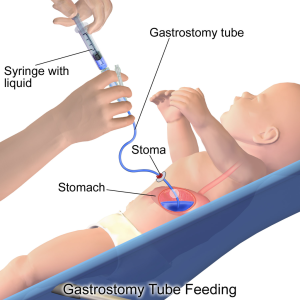
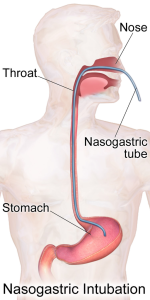
Inhalation: The most common way to administer medication via this route is inhalers. There are a number of different types of inhalers, and they vary depending on the medication and the reason for administration. There are also medications that can be given in gas form through the inhalation route. Figure 7.6 shows three different types of dry powder inhalers. With these inhalers, the patient breathes in a standard amount of a dry powder for each dose. The blue inhaler (Figure 7.5) is a metered dose inhaler that also provides a set dose per inhalation of medication.
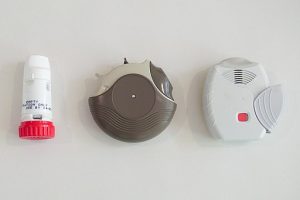
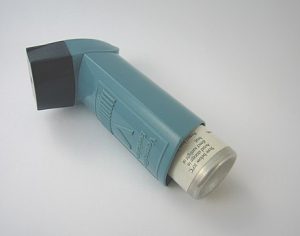
Parenterally: There are three common routes that are considered parental: intravenous (IV), subcutaneous (sc), and intramuscular (IM). The intravenous route delivers medication through an IV line that is connected to a small catheter in the patient’s vein. This route will be discussed in more detail later in the chapter. The subcutaneous (SC) and intramuscular (IM) routes are both injections, but the subcutaneous route delivers medication into the deepest layer of the skin, which is comprised of fats and tissues, and the intramuscular route (IM) delivers medication into the muscle. All these routes have different benefits and drawbacks; for example, the therapeutic effects of medication given via an IV occur faster but do not last as long as medication given via other routes. Figure 7.7 below shows varying sizes of syringes, and Figure 7.8 illustrates the difference between SC, IM, and IV medication administration.
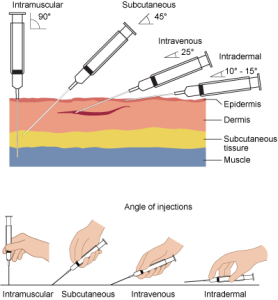
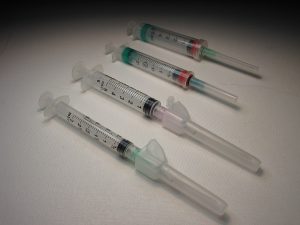
Rectally: The rectal route is used when a patient has issues taking medication orally. It is also commonly used with children because many young patients are unable to take medication orally or have difficulty swallowing medication. Some pain medication can be given through the rectal route in the form of suppositories, but others can be given in the form of creams, lotions, or ointments. If a patient is constipated or needs contrast for a scan, then they can be given an enema. The abbreviation for the rectal route is pr.
Vaginally: Although most suppositories cannot be given vaginally, there are some that can. There are also a number of creams and ointments that can be administered this way. The abbreviation for this route is pv.
Drops: Various solutions can be given either into the eye, ear, or nose, depending on the reason for administration. Some common medication types are antibiotics, numbing agents, and lubricating drops. The abbreviation for drops is gtt.
Topically: A number of different forms of medication can be given topically, including lotions, creams, ointments, and powders. Although many of these are similar in nature, the main difference is the amount of oil or water that is used in combination with the active parts of the medication. Topical medications typically work locally, which means they only have a therapeutic affect on the area they are administered on.
Transdermal patches: This route is very similar to the topical route, but there are differences. Transdermal patches are applied to the skin and left on so the medication can be absorbed slowly. A common example of this is the nicotine patch (Figure 7.9), which is used to help people quit smoking. Other common reasons that medications are given via this route is for pain, heart issues, depression, pregnancy prevention, and nausea. Another difference between transdermal patches and the topical route is that medication given transdermally usually acts systemically, which means it has a therapeutic effect throughout the body rather than just locally.
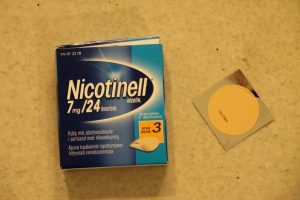
Review Exercise
Attribution
Unless otherwise indicated, material on this page has been adapted from the following resource:
Ernstmeyer, K., & Christman, E. (Eds.). (2020). Nursing pharmacology. Chippewa Valley Technical College. https://wtcs.pressbooks.pub/pharmacology/ licensed under CC BY 4.0
Image Credits (images are listed in order of appearance)
Nasogastric intubation by BruceBlaus, CC BY-SA 4.0
Gastric Feeding Tube Infant by BruceBlaus, CC BY-SA 4.0
Inhaler1 by ben dalton, CC BY 2.0
Dry powder inhalers by BrettMontgomery, CC BY-SA 4.0
Syringe with needle (2) by Intropin, CC BY-SA 3.0
Needle-insertion-angles-1 by British Columbia Institute of Technology (BCIT), CC BY 4.0
NicotinePatch by Styroks, CC BY-SA 4.0

